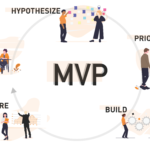In the fast-paced and competitive business landscape, successful product development is essential for the growth and sustainability of startups and established companies alike. It requires a well-structured and innovative approach to meet customer needs and stay ahead of the competition. In this comprehensive guide, we will explore six key strategies for successful product development. From ideation to market launch, we will delve into actionable insights, real-world examples, and expert tips to help you achieve excellence in product development and drive your business to new heights.
Understanding Market Needs: The Foundation of Product Development
“Your most unhappy customers are your greatest source of learning.” – Bill Gates, Co-founder of Microsoft
To develop a successful product, you must deeply understand your target market and their needs. Key steps to follow include:
- Market research and analysis: Conduct thorough market research to identify existing gaps, trends, and opportunities.
- Customer profiling: Create detailed buyer personas to gain insights into your target audience’s preferences, pain points, and behaviors.
- Problem validation: Validate the existence and severity of the problem your product aims to solve through surveys, interviews, and feedback sessions.
- Competitor analysis: Analyze your competitors’ offerings and identify areas where your product can provide a unique value proposition.
Ideation and Conceptualization: Turning Ideas into Viable Concepts
“Innovation distinguishes between a leader and a follower.” – Steve Jobs, Co-founder of Apple Inc.
Successful product development starts with a solid ideation process. Consider the following strategies:
- Brainstorming and creativity sessions: Encourage collaborative idea generation with cross-functional teams to foster diverse perspectives.
- Prototyping and validation: Develop minimum viable products (MVPs) to test your concepts and gather real-world feedback from users.
- Prioritization and roadmapping: Use frameworks like MoSCoW or RICE to prioritize features and create a clear product development roadmap.
Agile Product Development: Embracing Flexibility and Iteration
“Be stubborn about your goals and flexible about your methods.”
Incorporate agile principles into your product development process to adapt and respond to changing market dynamics:
- Cross-functional teams: Form multidisciplinary teams to ensure seamless collaboration and rapid decision-making.
- Sprints and iterations: Break down development into manageable sprints with regular review cycles to iterate and improve your product incrementally.
- Continuous feedback loops: Foster open communication and gather feedback from users, stakeholders, and team members throughout the development process.
User-Centric Design: Crafting Intuitive and Delightful Experiences
“Design is not just what it looks like and feels like. Design is how it works.” – Steve Jobs, Co-founder of Apple Inc.
Prioritize user-centric design to create products that resonate with your target audience:
- User research and testing: Conduct usability tests and user interviews to understand how users interact with your product and identify pain points.
- Prototyping and wireframing: Create interactive prototypes to visualize and refine the user experience before investing in full development.
- Iterative refinement: Continuously improve your product based on user feedback and evolving user needs.
Streamlining Development: Collaborative and Efficient Workflow
“Individuals don’t build great products; teams do.” – Sujan Patel, Growth Marketer
Efficient collaboration and workflow are crucial for successful product development:
- Agile project management: Use tools like Kanban or Scrum to optimize project flow and ensure tasks are completed on time.
- Clear communication channels: Foster transparent and regular communication within the team to avoid misunderstandings and delays.
- Quality assurance and testing: Implement rigorous testing protocols to catch and address issues early in the development process.
Market Launch and Post-Launch Analysis: Maximizing Impact
“Stay committed to your decisions, but stay flexible in your approach.” – Tony Robbins, Motivational Speaker
A successful product launch is just the beginning. To achieve sustained success:
- Go-to-market strategy: Develop a comprehensive plan to launch your product, including marketing, sales, and customer support efforts.
- Analyze performance metrics: Monitor key performance indicators (KPIs) and user feedback to identify areas for improvement and future enhancements.
- Continuous improvement: Continuously gather insights from data and user feedback to refine your product and maintain a competitive edge.
Successful product development requires a combination of market insight, innovation, and agile execution. By understanding market needs, embracing agile principles, prioritizing user-centric design, and fostering efficient collaboration, you can develop products that delight customers and drive business growth. Remember, product development is an iterative process that requires continuous learning, adaptation, and commitment to excellence.
Tips for 6 Strategies for Successful Product Development:-
- Emphasize Clear Communication Channels:
- Conduct regular team meetings to discuss progress, challenges, and next steps.
- Utilize project management tools to track tasks, deadlines, and updates in real-time.
- Maintain a centralized repository of project documents for easy access and reference.
- Foster a Culture of Collaboration:
- Encourage open discussions and value input from all team members.
- Appreciate diverse perspectives to promote innovative thinking.
- Recognize and celebrate team achievements to foster unity.
- Set Clear Goals and Objectives:
- Define SMART goals (Specific, Measurable, Achievable, Relevant, Time-bound).
- Break down the product development process into smaller, manageable tasks.
- Promote Continuous Feedback:
- Conduct regular feedback sessions to discuss progress and challenges.
- Gather feedback from customers to understand their needs.
- Empower Innovation and Experimentation:
- Dedicate specific time for team members to explore new ideas.
- Encourage a fail-fast approach to learn from mistakes quickly.
- Celebrate Milestones and Successes:
- Recognize and celebrate progress at key stages of the product development process.
- Organize team-building activities to boost team spirit.
FAQS:-
1Q: What is the importance of product development in a business?
A: Product development is crucial for a business as it allows the company to create and introduce new products or improve existing ones to meet changing market demands, customer preferences, and stay competitive in the industry. Successful product development can lead to increased revenue, market share, and customer loyalty.
2Q: What are the key strategies for successful product development?
A: The article outlines six strategies for successful product development, which include: a. Conducting thorough market research to identify customer needs and pain points. b. Fostering a culture of innovation within the organization to encourage creative thinking and idea generation. c. Prioritizing collaboration and cross-functional communication among different departments involved in the product development process. d. Adopting an agile approach to product development, allowing for flexibility and adaptability to changing requirements. e. Testing and validating prototypes and concepts with target customers to gather feedback early in the development process. f. Investing in talent and technology to support the product development efforts effectively.
3Q: How does market research impact product development success?
A: Market research plays a vital role in product development success by helping businesses understand their target audience, identify market trends, and uncover unmet customer needs. By gathering data and insights through market research, companies can make informed decisions about the features, design, and pricing of their products, increasing the chances of creating products that resonate with the market.
4Q:-How can a company foster a culture of innovation?
A:-Fostering a culture of innovation involves creating an environment where employees are encouraged to think creatively, share ideas, and take calculated risks. This can be achieved by promoting open communication, recognizing and rewarding innovative efforts, providing resources for experimentation, and giving employees the freedom to explore new concepts without fear of failure.
Stay updated with the latest in the startup world through our Startup News and Funding Alert. Sections. Explore Founder Profiles, Startup Profile, Founders Interview, Success Stories. In-depth Insights articles, Resources, and How to. Follow us on Facebook, Twitter, Instagram and LinkedIn for regular updates.
Last Updated on Wednesday, July 26, 2023 7:22 am by Navaneetha


